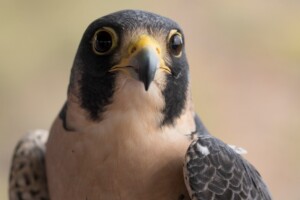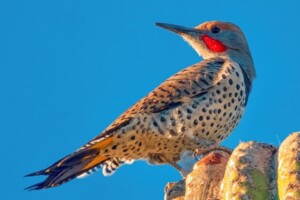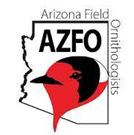LONG-TERM BIRD MONITORING
Why It Matters
Beyond their beauty and interesting behaviors, birds provide countless ecosystem benefits. Some serve as pollinators or seed dispersers, whereas others help keep prey species in check or keep the environment clean by scavenging dead animals. Many build habitats used by other species, such as nest-building or creation of tree cavities. All are an important link in the food chain. Additionally, because birds are sensitive to the condition of their habitat, bird density can be used as an indicator of ecological condition.1,2
Unfortunately, 20% of bird species worldwide are of global conservation concern.3 We have lost 3 billion birds (29%) since 1970,4 and the populations of 3,967 bird species (40% of global bird species) are declining.3 Threats of agricultural expansion, logging, overexploitation, urbanization, pollution, disturbance, the effects of invasive species, and climate change are driving these unprecedented declines. Surveys and monitoring are essential for understanding where birds occur, causes of their decline, and how to effectively protect species and the habitats on which they depend.
The Conservancy’s Work
In 2012–2013, the Conservancy conducted baseline data surveys in Scottsdale’s McDowell Sonoran Preserve: diurnal surveys were done six times per year at six sites, and nocturnal surveys were done twice per year at two sites.  Periodic surveys continued at these sites until 2018, when robust annual monitoring began. Three diurnal sites were added for a total of nine diurnal and two nocturnal survey routes. Diurnal sites are surveyed three times per year to capture seasonal fluctuation; nocturnal sites are surveyed once in late May.
Periodic surveys continued at these sites until 2018, when robust annual monitoring began. Three diurnal sites were added for a total of nine diurnal and two nocturnal survey routes. Diurnal sites are surveyed three times per year to capture seasonal fluctuation; nocturnal sites are surveyed once in late May.
During these surveys, Audubon Important Bird Area (IBA) survey protocols are followed to be able to compare trends in the Preserve with other areas across Arizona. The IBA approach enables inventory of birds by habitat, documentation of breeding bird status, and detection of changes in abundance or composition at a particular site within similar habitat types.
In addition, the Conservancy participates in community science surveys,  including Global Big Day and the Christmas Bird Count, which ensures that bird trends in the Preserve are included in these important national and global datasets and analyses. The Conservancy also collects bird data through informal bird walks, educational activities, and incidental observations. All data are shared on eBird so that they may be used to better understand trends in bird diversity. The Preserve provides important habitat that protects common species and desert specialists alike.
including Global Big Day and the Christmas Bird Count, which ensures that bird trends in the Preserve are included in these important national and global datasets and analyses. The Conservancy also collects bird data through informal bird walks, educational activities, and incidental observations. All data are shared on eBird so that they may be used to better understand trends in bird diversity. The Preserve provides important habitat that protects common species and desert specialists alike.
What’s Been Found
The Preserve provides habitat for at least 185 species of birds, 20 of which are considered sensitive or are experiencing global declines, such as bald and golden eagles, peregrine falcon, purple martin, and gilded flicker. To help engage visitors in caring about birds, as well as to bolster important data, the Conservancy created a Preserve bird list, available on our website.
How You Can Help
Tracking biodiversity trends is one of the best ways we can protect Sonoran Desert species and their habitats. That’s why we need your support. You can ensure the desert will continue to thrive and be a place to enjoy for all, now and for future generations to come.
- Reference the McDowell Sonoran Preserve bird species check list and submit data to eBird
- Learn more about birds through Merlin, Sibley, and iBird.
- Teach children how to identify birds and appreciate their role in nature.
- Participate in the Christmas Bird Count and Global Big Day
- Be bird friendly through these simple ideas:
- Make your yard a bird oasis: use native plants and provide proper food, water, shelter, and nesting sites
- Encourage municipal and corporate native habitat planning and planting
- Keep your cats indoors (for their safety and for birds)
- Use only dark sky friendly outdoor lighting to provide safe passage to migrating birds.
- Safeguard your windows to prevent bird collisions
- Become familiar with local wildlife rehabilitation centers
- Put up nest boxes for local cavity nesting birds
- Avoid use of toxic pesticides
- Eliminate single use plastics
- Support McDowell Sonoran Conservancy with a gift or volunteer as a Conservancy Steward
Partners:
Walter Thurber, Arizona Field Ornithologists
Tice Supplee, Director of Bird Conservation, Audubon Southwest
McDowell Sonoran Conservancy Contact:
Jessie Dwyer | 480-998-7971 ext. 104 | jessie@mcdowellsonoran.org
15300 North 90th Street, Suite 400, Scottsdale, Arizona, 85260 | 480-998-7971



Literature cited:
- O’Connell, T. J., Jackson, L. E. & Brooks, R. P. Bird Guilds as Indicators of Ecological Condition in the Central Appalachians Author ( s ): Timothy J . O ’ Connell , Laura E . Jackson , Robert P . Brooks Published by : Ecological Society of America Stable URL : http://www.jstor.org/stable/2641233. Ecological Applications 10, 1706–1721 (2000).
- Bock, C. E., Jones, Z. F., Bock, C. E. & Jones, Z. F. Avian habitat evaluation : shoul. 2, 403–410 (2017).
- BirdLife International. State of the world’s birds: taking the pulse of the planet. (2018).
DISCOVER MORE
Protect Your Sonoran Preserve
The Power to Sustain the Sonoran Desert for Future Generations is Yours

